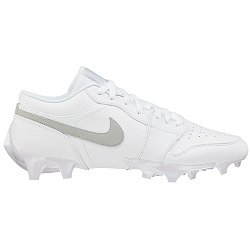Men's Football Cleats Buying Guide
Think about the construction of your football cleat when you're gearing up for the season.
Uppers: The upper portion of a cleat is designed to withstand impact and rough weather conditions. Your upper should be lightweight yet tough—cut for a snug and adaptive fit to your foot and ankle. Uppers are constructed with leather and synthetic materials. The latest generation of football cleats are crafted with innovative materials, engineered to deliver lockdown fit without sacrificing durability and breathability.
Popular Synthetic Materials in Men's Football Cleats: Pebax® is a thermoplastic elastomer that's resistant to impact and withstands harsh weather temperatures. This material does not stiffen when conditions are cold and wet. Thermoplastic polyurethane is lightweight and water-resistant, even in extreme temperatures. Other innovative synthetic materials are available, including ethyl vinyl acetate and PORON®.
Midsole: The midsole of your cleat offers cushion for your foot. Different styles of midsoles may provide support, cushion or impact absorption.
Sockliner: Your football cleats may include an internal sockliner. Inner liners wick away sweat and improve both comfort and the fit of the footwear. In addition to the liner, a lightweight foam padding, including EVA, provides cushioning without weighing down the shoe.
Outsole: The outsole is the bottom of the cleat. This feature is typically made of molded plastic or rubber and helps provide extra stability.
Studs/ Cleats: One of the most important factors in a football cleat is the construction and stud configuration along the outsole. Think about your typical playing conditions and your own personal preferences when choosing the right studs and cleats:
Molded cleats are permanently attached to the shoe. These molded rubber or plastic cleats provided added traction on turf or dry and cold grounds. They're ideal for players who will take on a variety of different surfaces.
Detachable cleats perform well on natural grass fields. Change your detachable cleats when they become worn or to better suit a field condition. Longer studs bite into muddy and wet field conditions, while shorter cleats are better suited for artificial fields. Replacement cleats are available in a variety of sizes, so you can customize your shoe's traction.
Heel: The heel of a football cleat typically has a heel counter on the back to help prevent the heel from collapsing.
Cleat Accessories
Spats or Cleat Tape: Need to enhance stability on the field? Try pairing your football cleat with a spat, which provides a glove-like fit, or cleat tape around your joint to help promote agility and prevent rollover.
Shoelaces: Broken shoelaces can impede your game. Keep an extra pair of shoelaces on hand in case one breaks at practice or in a game.
Replacement Studs: If you have detachable cleats, you may need to purchase replacement studs. Be sure to buy the correct stud size to avoid changing the balance or feel of your cleats.
Get everything you need for the field with the complete collection of football gear and equipment at DICK'S Sporting Goods.




















































